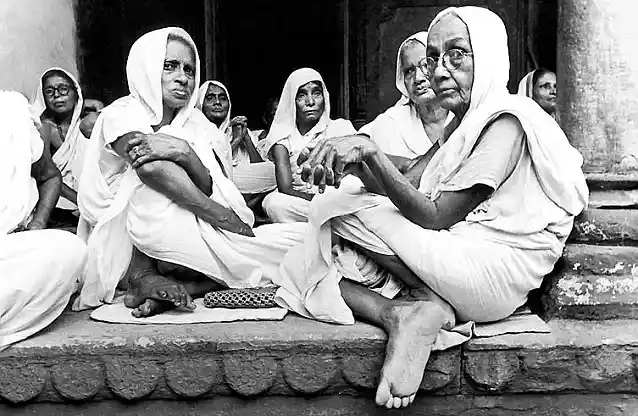Remarriage of Widows Finally Legalized
The Hindu Widows' Remarriage Act, 1856 was legalized on this day in 1856 under the rule of the British Empire in response to the centuries-long inhumane treatment given to widows in India. This Act authorized certain rights of widowed women which they have been viciously robbed of.

Widow re-marriage legalized. Illustrated by Anupama: Visual Storyteller at ThisDay
Since time immemorial, the status of widows in society has always been questionable. After being subjected to completely unjust customs, for a long time they were barely treated as human, which sadly is still prevalent in many societies. The patriarchal system shows its truest colour in the form of it casting widowed women aside as if their worth becomes negligible with the death of their husbands. Although they are still alive, they lead a life in comparison to walking through the gates of hell, for they are completely stripped down from enjoying any joys of life. Barred from festivals, robbed of good food, forced to wear white sarees to brand them as different, Hindu widows, especially during the era of British in India received no respect or empathy.
Yet, women at that time were deeply oppressed anyway, and if you were a widow, you were thrown at the bottom of the ladder which was itself placed below. Medieval India proved itself to be the worst time to live in if you were a woman due to the normalcy of practices such as child marriage and Sati. The arrival of the British in India created havoc in the country for sure. However, their own selfish reasons caused some boon to the plight of women at that time. The inhumane tradition of Sati, which consisted of a widowed woman forced to walk headlong into the funeral pyre of her husband, was banned under the British in 1826, with the help of Raja Ram Mohan. This stirred up further acts aimed at bringing social and religious reforms.
Contrary to popular beliefs, the banning of Sati didn’t drastically improve the lives of widows in the country. Widows were still completely cast aside, and blamed for the death of their husbands, ensuring they remain in mourning for the rest of their lives. Condemned to a life of austerity and abnegation, they were given no say in how they wanted their lives to proceed. Despite having their whole life ahead of them, they were robbed of the opportunity of remarrying and starting afresh. On top of that, men themselves were wary of marrying widows, as they believed them to be tainted.
A turning point in their lives emerged soon with the Bengal Renaissance which produced an important figure named Ishwar Chandra Vidyasagar. He led the cause for the legalization of the remarriage of widowed women, which was implemented under the authority of Lord Canning. On this day in 1956, the Hindu Widows' Remarriage Act was legalized and further enacted on the 25th of the same month.
According to this act, “No marriage contracted between Hindus shall be invalid, and the issue of no such marriage shall be illegitimate, by reason of the woman having been previously married or betrothed to another person who was dead at the time of such marriage, any custom and any interpretation of Hindu Law to the contrary notwithstanding.”
Surprising to all is the fact that this act applied mainly towards upper-caste Hindu families, for the poor never practised any such traditions in the first place, with the remarriage of widows already being prevalent amongst them. This act authorized the control of the women’s inheritance by her deceased husband to herself, giving her the right to either forfeit or claim it all despite remarrying.
Although a historic act, sadly it only proved to be revolutionary on paper. Decades after this act has been passed, widows are still considered to have lost all their social value in front of their families.
According to the New York Times in 2019, “Without a husband, a small portion of India’s approximately 40 million widows are violently purged from their homes each year.”

With the growing improvement of the status of women in comparison to what it was earlier, the conditions of a widow are surely better by a long shot. However, this change is catered mostly to the urban population, as many conservative families continue this vicious treatment of their widowed women.
A turning point in their lives emerged soon with the Bengal Renaissance which produced an important figure named Ishwar Chandra Vidyasagar. He led the cause for the legalization of the remarriage of widowed women, which was implemented under the authority of Lord Canning. On this day in 1956, the Hindu Widows' Remarriage Act was legalized and further enacted on the 25th of the same month.
According to this act, “No marriage contracted between Hindus shall be invalid, and the issue of no such marriage shall be illegitimate, by reason of the woman having been previously married or betrothed to another person who was dead at the time of such marriage, any custom and any interpretation of Hindu Law to the contrary notwithstanding.”
Surprising to all is the fact that this act applied mainly towards upper-caste Hindu families, for the poor never practised any such traditions in the first place, with the remarriage of widows already being prevalent amongst them. This act authorized the control of the women’s inheritance by her deceased husband to herself, giving her the right to either forfeit or claim it all despite remarrying.
Although a historic act, sadly it only proved to be revolutionary on paper. Decades after this act has been passed, widows are still considered to have lost all their social value in front of their families.
According to the New York Times in 2019, “Without a husband, a small portion of India’s approximately 40 million widows are violently purged from their homes each year.”

With the growing improvement of the status of women in comparison to what it was earlier, the conditions of a widow are surely better by a long shot. However, this change is catered mostly to the urban population, as many conservative families continue this vicious treatment of their widowed women.

Segregation of Widows during the British Era; Image Source: Jagran Josh


